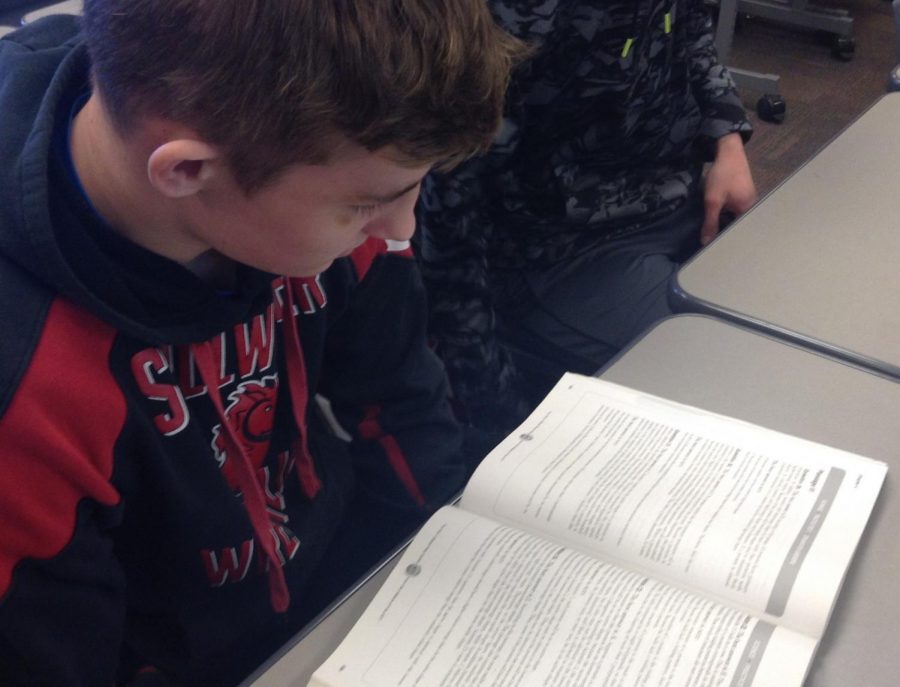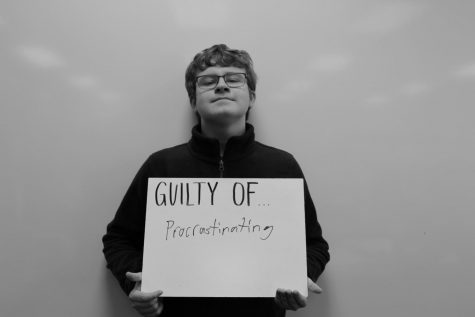ACT testing adds unneeded stress and provides an unfair advantage
Junior Tyler Olson studies an ACT Prep Class textbook. Many students take time out of their classes to study for the ACT, which interferes with their focus and learning experience during class time.
February 18, 2020
For many college-bound students, the ACT or SAT tests present the largest hurdle in high school. What is intended to be a test of one’s ability too often becomes a stressful, inaccurate and even unfair. Colleges should find less stressful and more balanced ways to determine a student’s eligibility for admission or scholarships than standardized tests.
The ACT and SAT tests are designed to demonstrate a student’s ability to take standardized tests. While Minnesota does not require students to take the ACT or SAT, over 90 percent of colleges still require a score for admission or potential scholarships. Last year, over 2.2 million students took the SAT, and another 1.8 million took the ACT. Considering the widespread application of these standardized tests, they can have a massive impact on high school student’s life.
After taking the ACT or SAT, some students doubt the accuracy of the test. 2019 graduate Hannah Ferguson was perplexed when the ACT said her best category was math and her worst was english,”which is like the opposite” of her strengths.
While this inconsistency may be due to a plethora of reasons, if a student is not able to demonstrate their actual skill, that reflects false information about that student’s capabilities.
Furthermore, due to the length and size of the tests, many students suffer from fatigue, which can affect their scores. Junior Jack Skare said the ACT was mentally draining, even with a break and sugary snacks he brought to wake himself up. The size of the test can shift the challenge from knowledge to endurance, which contradicts the purpose of these exams.
A major repercussion of large standardized testing is additional stress. Junior year, often considered the hardest year for students, is also the year most students take the ACT or SAT. This often involves extra resources preparing for the exams.
In the weeks prior to taking a test, many students feel anxious about the coming exam, adding additional stress.
“As it got closer and closer you’re like, ‘Okay, this big test is coming up,” explained Skare.
Additional stress can distract students in class, impacting their grades, and often hurting their mental health as well. One of the best ways to reduce anxiety according to an ACT study, is to prepare for a test by studying a textbook or taking a prep class, both of which take time and money.
If a student lacks the time or money to take a prep class, “I would say they are at a disadvantage,” Skare said, “because my prep course helped out a lot to prepare for the test. If you just read the ACT book that the ACT has it, it might not help you as much”.
As many juniors are starting their first job and trying to balance everyday schoolwork, adding an additional ACT or SAT prep class into their schedule proves to be a hassle, unless you aren’t in any extracurriculars or taking the class during the summer, explained Skare.
In addition, by taking up time and money, prep classes, as well as standardized tests, feed into the greater racial wealth inequality in the United States. African Americans, Latinos, Asians and other lower class students lack the resources students with time and money have to prepare. This reduces their scores, chances of college admission, and possibly their careers.
Colleges have to turn away from standardized testing as a measurement of eligibility, as it adds additional teenage angst, can be unreliable and is unfair to poorer students. Looking more into what students have accomplished, through their GPA and extracurricular activities, is a far more accurate test of one’s abilities.












Mia Lucido • Mar 5, 2020 at 8:31 pm
I really enjoyed this article! There is a lot of information that’s broken down to be easily understood. You had a clear position and stuck with it the entire article with good quotes and facts to back it up.
Rachel Duerr • Mar 1, 2020 at 1:28 pm
I loved this article! It was a beneficial topic for both parents and students to read about. Nice job on the reasoning on what the ACT measures and how it isn’t the best way to measure someone’s intelligence. I liked how you got the students honest and raw opinion about the test. Great job!
Stella • Feb 27, 2020 at 10:18 am
I loved your story, Lucas, I think it is something many students can relate to. I like how you made points about how when taking that long of a test students get tired and it makes it harder. I also like how you talked about prep courses and the time spent studying on top of regular classwork and other things students having going on in their lives. You brought in many good points and kept it interesting through the end. Great work!
Eleanor Gag • Feb 27, 2020 at 9:06 am
Good job Lucas! This story was really relatable and it kept me very interested. You did a good job displaying the stress that us students have. You used effective quotes and wording.